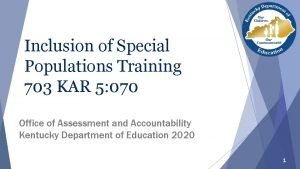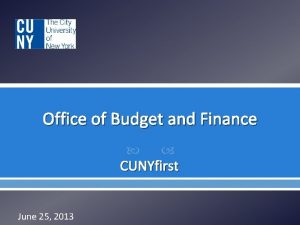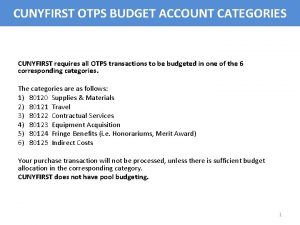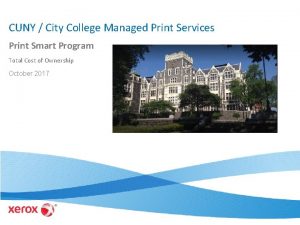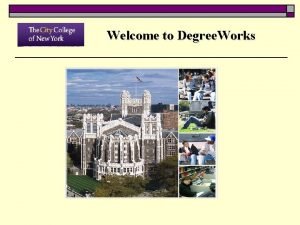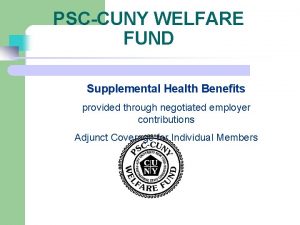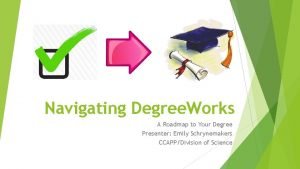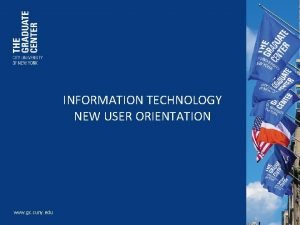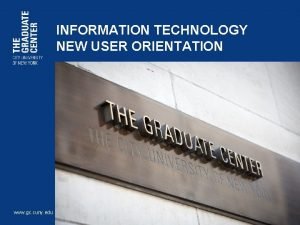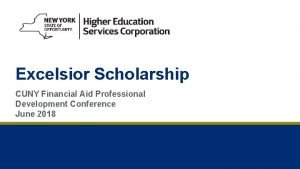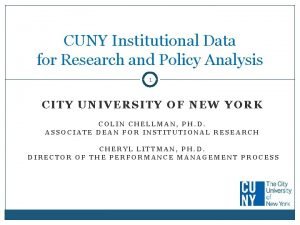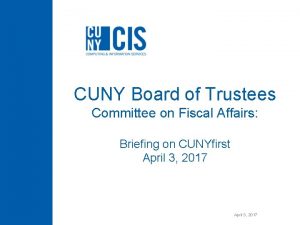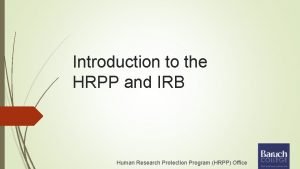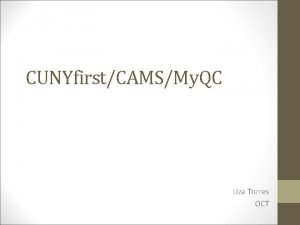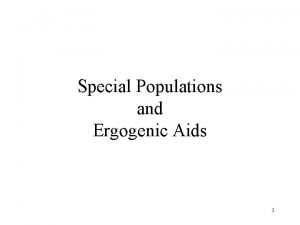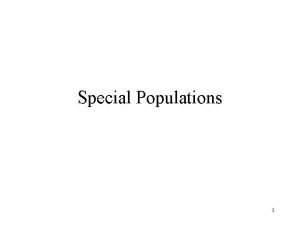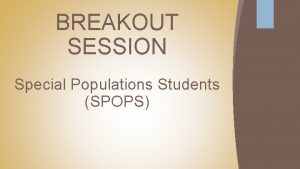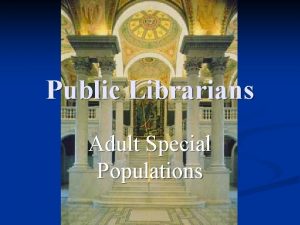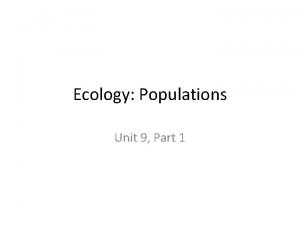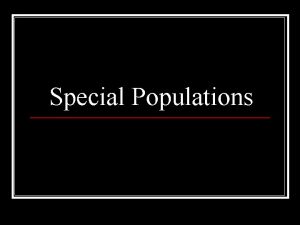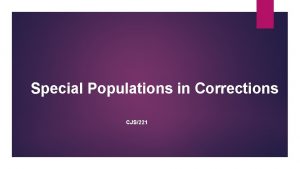College Planning for Special Populations PART 2 CUNY
















- Slides: 16

College Planning for Special Populations (PART 2) CUNY COLLABORATIVE PROGRAMS: A NYGEAR UP PARTNER

Agenda: Special Populations q Part 1 § Undocumented Youth § English Language learners § Immigrant and Refugee families q Part 2 § Youth with Disabilities § Homeless Youth § Youth in Foster Care

Youth With Disabilities CUNY COLLABORATIVE PROGRAMS: A NYGEAR UP PARTNER

The Individualized Education Program (IEP) and 504 Plans q The Individualized Education Program (IEP) is a written statement of the Department of Education’s plan to provide your child with special education services in the least restrictive environment. q Least Restrictive Environment (LRE) means that your child will be educated alongside his or her non-disabled peers for as much of the day as possible. q 504 Plans outline how a child’s specific needs are met with accommodations, modifications and other services. These measures “remove barriers” to learning. For example, students with ADHD might qualify for a 504 plan. q IEP vs. 504: 504 s have a broader definition of disability and can include something like attention deficit. 504 s will outline any changes to the learning environment to meet the child’s needs, whereas IEPs outline any special educations services.

Diploma Information for Students with IEPs q Option 1: Advanced Regents Diploma • Score 65+: ELA, 3 math, any social studies, 2 science, any additional state-approved Regents, and any NYC languages other than English exam q Option 2: Regents Diploma • Score 65+: ELA, any math, any social studies, any science, and any additional state-approved Regents q Option 3: Local Diploma • Allows students who meet specific criteria to graduate with lower exam scores q Option 4: Two Non-Diploma Credentials that demonstrate career-readiness • Career Development and Occupational Studies Commencement credential: academic and personal behaviors in the workplace • Skills and Achievement credential: supports the attainment of career-readiness skills

College planning for students with IEPs The college plan focuses on: § Instruction to help the student achieve his or her individual goals; § Building employment skills and other tools for adult life; § Community integration; § Developing daily living skills (for students who require this kind of assistance)

Sample Transition Plan Student Exit Summary: § Student’s Post-secondary Goals § Recommendations for reaching Post-secondary Goals § Identify organizations that can support student

What is the Role of a High School Student in Transition Planning? § Use the school’s career center/guidance counselor to identify interests and find out what education and training are required. § Complete interest inventories to identify interests, skills, abilities, and aptitudes as they relate to employment. § Do volunteer work or entry-level jobs in field(s) of interest. § Shadow or interview adults in jobs or career fields that interest them. § Visit colleges and other post-secondary training sites.

Self-Advocacy K-12 College Disability services are offered every year that meet the individual needs of every student Student must self-identify to the Office of Disability Services at their school School provides evaluation at no cost to the student Primary responsibility for arranging accommodations belongs to the student Student is identified by the school and is supported by parents and teachers Students with disabilities need to advocate for themselves School is responsible for arranging individualized accommodations Professors will most likely be open and helpful, but only after the student expresses their needs in the classroom

Homeless Youth/ Youth in Foster Care CUNY COLLABORATIVE PROGRAMS: A NYGEAR UP PARTNER

Rights of Homeless Youth q The right to equal access to free public education q The right to remain in the school they were attending before they became homeless q The right to transportation to their school

Transition Planning for Homeless Youth With district support, planning includes: § College selection and application process § Financial Aid and the student’s rights as an unaccompanied youth § Awareness of college supports (including housing choices, employment options, transportation options and academic supports)

FAFSA: The Special Circumstances Students must prove their independence to financial aid administrators, who will then make the determination regarding their dependency status. To do so: q Students must fill out the FAFSA forms q On the FAFSA, students indicate that they fall under the “special circumstances” category and cannot provide their parents’ information. q Students should immediately follow up with the college financial aid office to determine if any additional documentation or information is needed.

The New York State Tuition Assistance Program (TAP) To qualify as an independent student: § A ward of the court (not including status as an inmate). § Are receiving public assistance under your own budget and not as a dependent of your parents. § Other circumstances that result in parents losing guardianship

Campus Supports q CUNY FOSTER CARE COLLABORATIVE: a one-stop website detailing a range of CUNY resources, program, services, and supports available to students in care at CUNY q SUNY Educational Opportunity Program (EOP): provides access, academic support and financial aid to students who show promise for succeeding in college but who may not have otherwise been offered admission q The Foster Youth College Success Initiative (FYCSI) is a new program specifically for foster youth who are either already in college or about to enter college designed to provide them with the necessary supports and financial assistance to help them achieve academic success and meet college expenses.

Questions Please complete the workshop evaluation form.
 Kde inclusion of special populations
Kde inclusion of special populations Psc cuny welfare fund retirees
Psc cuny welfare fund retirees Cunyfirst
Cunyfirst Cuny first
Cuny first Xerox smart cities
Xerox smart cities Degree works rice
Degree works rice Psc cuny welfare fund prescription
Psc cuny welfare fund prescription Degree audit cuny
Degree audit cuny Gc cuny portal
Gc cuny portal Gc cuny portal
Gc cuny portal Computer virus in hindi
Computer virus in hindi Cuny professional development conference
Cuny professional development conference Bcc geospatial center of the cuny crest institute
Bcc geospatial center of the cuny crest institute Cuny oira
Cuny oira Cuny board of trustees
Cuny board of trustees Cuny irb
Cuny irb Cams cuny
Cams cuny
